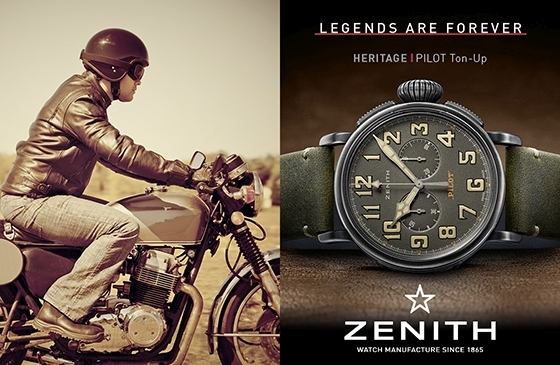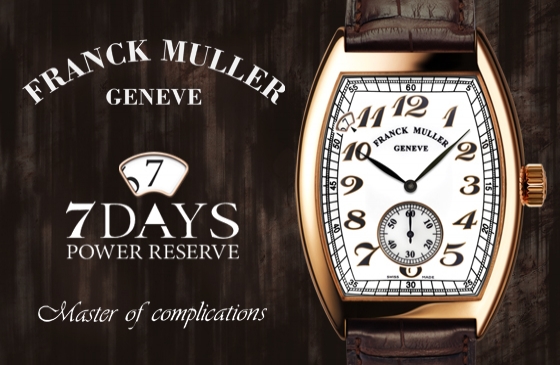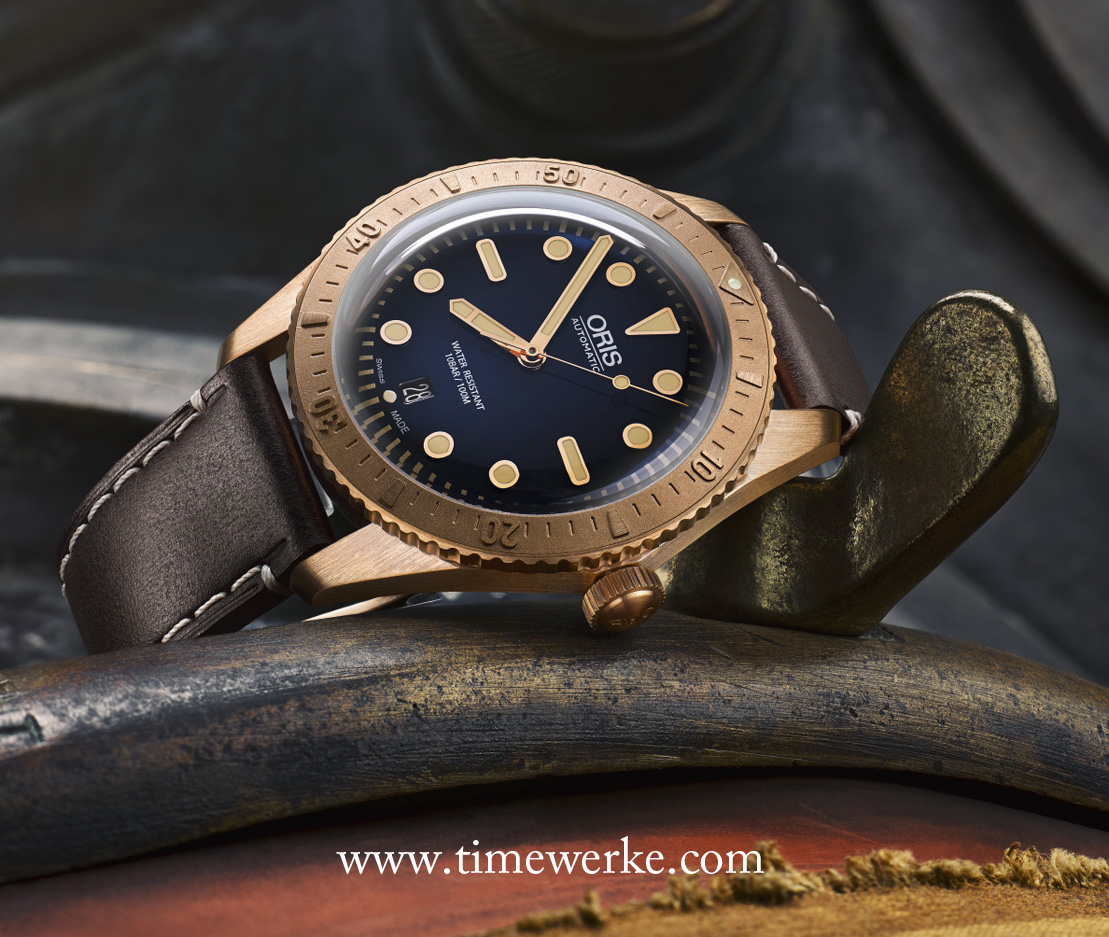
Oris Carl Brashear Limited Edition. Launched in 2016, it features a 42mm diameter case and unidirectional bezel made in bronze. It is powered by the Calibre 733 base Sellita SW200 automatic movement. This Oris Carl Brashear Limited Edition has a domed sapphire crystal and is water-resistant to 100 metres. Limited to 2,000 pieces, its recommended retail price is CHF2,600. Photo: © Oris
Who is Carl Brashear you ask? Well, perhaps you may already know, especially if you are a movie buff who had watched the 2000 Hollywood production, Men of Honor, starring Cuba Gooding Jr. (who plays Carl Brashear), Robert de Niro (Master Chief Billy Sunday) and Charlize Theron (Gwen Sunday).
He is not some fictional movie character but a true American hero. Carl Brashear (1931 to 2006) became the first African American to become a US Navy Master Diver even though he was handicapped with an amputated left leg.
Brashear had wanted to be in the military since young and enlisted in 1948, undergoing his basic military training at Great Lakes, Illinois.
He started out as a steward (culinary specialist) and thereafter handled aircraft for squadron VX-1 at Key West, Florida. Brashear eventually became boatswain’s mate. A boatswain is the officer in charge of equipment and crew onboard a ship.
Brashear then signed up for training in salvage diving. It was the 1950s and racism was rife for African Americans. In the words of Brashear himself, there was “… tremendous racism at that time”.
“In 1953, I faced a lot of racial discrimination in the diving camp in Jersey [located in Bayonne, New Jersey]. On two occasions, I found [racist and threatening] notes on my bunk but I ignored them,” said Brashear in a documentary on his exemplary military life.
Brashear was not just the first African American to attend the Diving and Salvage School; he was also the first African American to graduate from dive school in 1954.
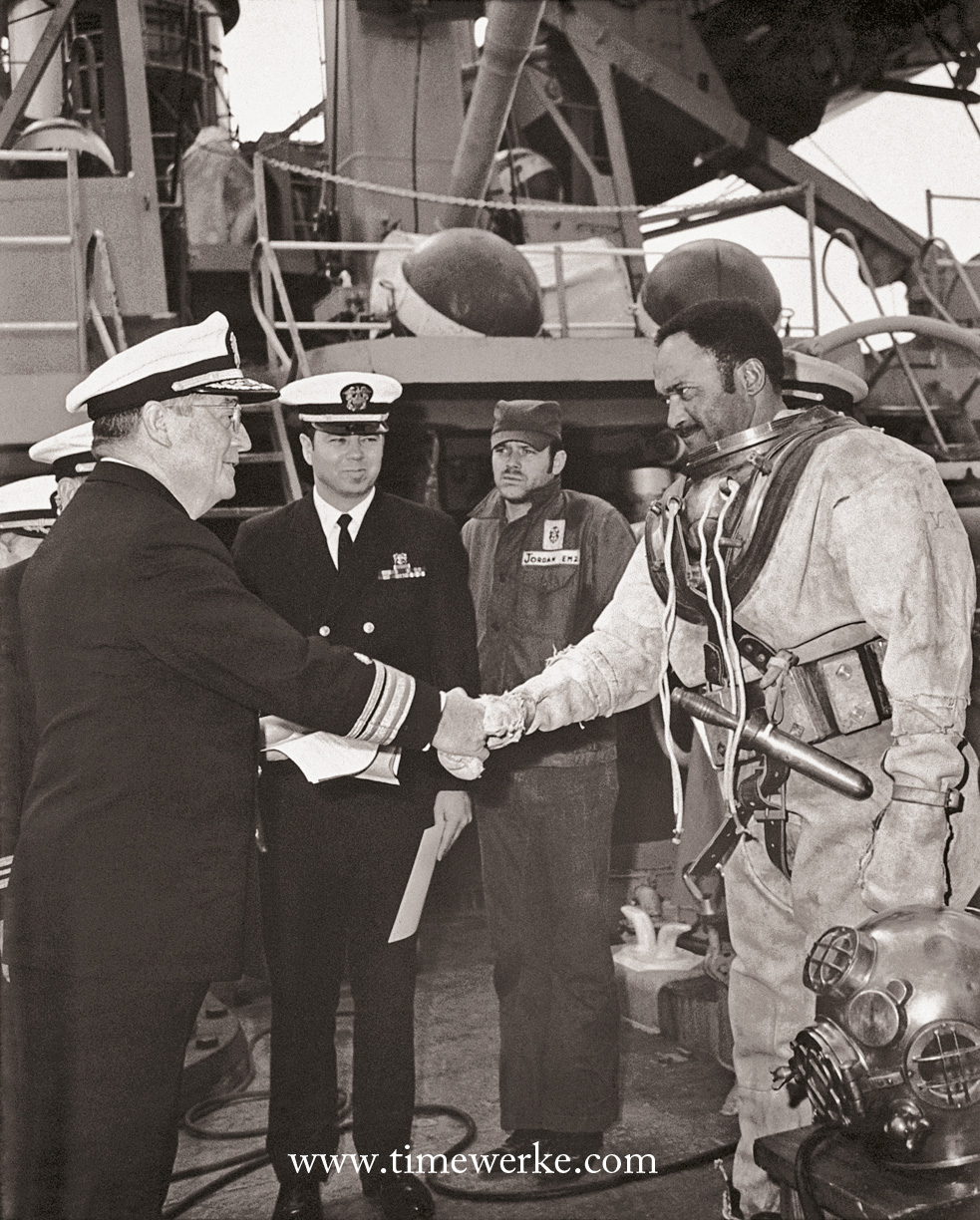
Carl Brashear in the dive suit of his time. Strapped around his waist is the weighted belt and a huge diving knife. Around his hands are wrist straps. The navy man in the background has the name tag: “Jordan” followed by EM2, indicating that he is a petty officer. In the foreground is the diving helmet which is typically made of copper and bronze. Photo: © Oris
In 1966, during the period of the Cold War (sometime between the 1940s to the early 1990s), Brashear was serving onboard the USS Hoist (ARS-40). The mission was to locate a two-tonne nuclear warhead that was lost when a US aircraft carrying it crashed off the coast of Spain in international waters.
It was a race to find the nuclear warhead before the Russians did. After 58 days, the Americans located the warhead. Aboard the USS Hoist, Brashear was on deck overseeing the recovery operations.
Midway through lifting the nuclear warhead, a lifting line gave way, causing a pipe to fly across the deck. Brashear instinctively pushed a colleague aside but instead placed himself in harm’s way.
The pipe smashed into Brashear’s lower left leg, almost severing it. Brashear survived but as his lower left leg developed gangrene, it had to be amputated.
Though Brashear could walk with the aid of a prosthetic limb, medical experts concluded that it was inconceivable for him to realize his ambition of becoming a master diver. He was therefore earmarked for military discharge due to his physical condition.
However, Brashear refused to sign his discharge papers and instead underwent demanding physical training with his artificial leg. “It would have been the end of my career. I had to convince the Naval Bureau of Medicine plus the Bureau of Naval Personnel that I could return to active duty as an amputee,” he noted.
Through sheer grit and determination, Brashear proved to the Navy’s medical board that he was still fit, being able to dive and perform his military duties well, even with his prosthetic limb.
In 1968, he obtained full active status. With this, Brashear became the first amputee to serves as a diver in the US Navy. Two years later in 1970, he obtained the rank of Master Diver, a status few will ever achieve, even if they are able-bodied.
“The Master Diver is the highest position in the diving specialty,” as highlighted by Brashear. Indeed, it is the highest dive qualification one can achieve in the US Navy.
Brashear officially retired from the US Navy on 1 April 1979, after 31 years of service. The Hollywood movie, Men of Honor, released in 2000, is about this American military hero.
Navy divers have to be well-trained and experienced for the diving jobs they perform. As said by Billy Sunday, played by Robert de Niro in Men of Honor, “Diving is the most dangerous role in the navy. If it is lost underwater, a navy diver finds it; he brings it up. If he is lucky, he’ll die young 200 feet beneath the waves for that is the closest he’ll ever get to being a hero.”
In 2016, Oris honours this legendary gentleman by naming its very first bronze watch the Carl Brashear Limited Edition. The case and unidirectional rotating bezel are made of bronze.
The choice of bronze is apt for that is one of the materials used for deep-sea diving helmets of the 1940s and 1950s. A Desco 29103 Mark V diving helmet made in the 1940s for instance, will have a shell made of heavy-spun copper fitted with bronze castings.
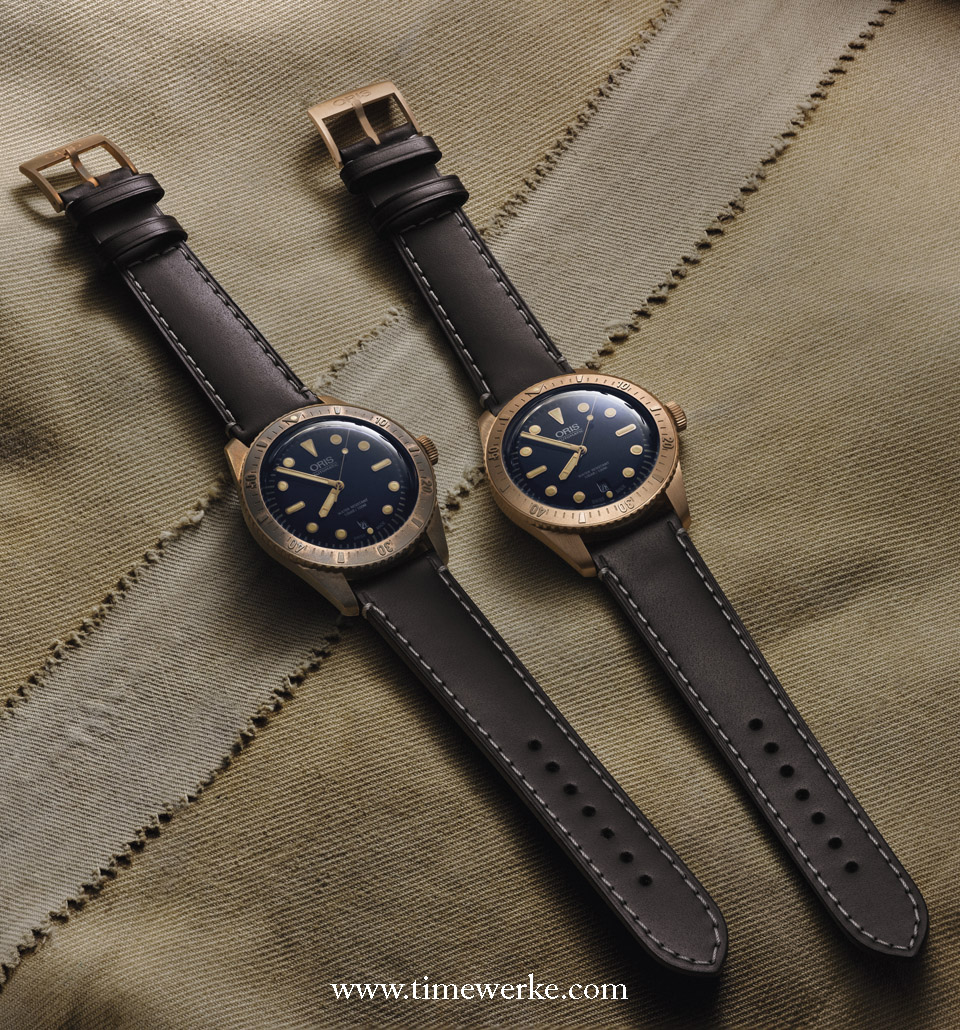
For the Oris Carl Brashear bronze watch, the brand highlights that bronze will initially be bright and shiny (Oris Carl Brashear on the right) but will darken as its copper content “reacts with carbon dioxide and moisture” (Oris Carl Brashear on the left). A dullish but unique patina will form over time and how it develops depends very much upon its wearer. Photo: © Oris.
Aesthetics-wise, the design element is similar to that of the Oris Divers Sixty-Five, a model which has a retro look inspired by its watches made during the 1960s.
For watch collectors interested in bronze watches, do take note that such a material ages naturally and it depends on the environment it is in.
A dullish but unique patina will form over time and how it develops depends very much upon its wearer. This is spoken from experience due to personal ownership of a few bronze timepieces.
The Oris Carl Brashear bronze watch pays tribute to a heroic man and supports the Carl Brashear Foundation.
In the movie, Men of Honour, one memorable line from Cuba Gooding Jr., who plays Carl Brashear is: “We have many traditions; some good, some bad. However, I wouldn’t be here today without our greatest tradition of all – honour, Sir.”
Indeed, Brashear won over the hearts and minds of naysayers with honour. For us, the Oris Carl Brashear is to be worn with honour (pun most definitely intended).
The Oris Carl Brashear is a timepiece that not only reminds us about the evils of racial discrimination but the courage and strength we should muster to overcome whatever the challenges in order to achieve our goals.

